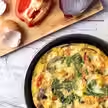A Beginner's Guide To A Wholefood, Plant-based Diet
- Emma Lisa

- Jan 19, 2024
- 12 min read
Updated: Nov 2
Whether you're interested in going plant-based for the health benefits, ethical or environmental reasons, this blog post is the beginner's guide to a wholefood plant-based diet. As a Nutritionist who is primarily plant-based herself, I am here to share the basics and empower you with the know-how to make this transition not only effortlessly, but also love the journey. Let's do this together!

What Is A Plantbased Diet?
Your typical plant-based diet is centred around wholefood foods that are sourced directly from just plants – think freshly picked veggies and fruits, wholesome grains, beans, peas, lentils, nuts, and seeds. The level of "no animal stuff" can vary person to person with some going all and fully vegan, and others choosing a more relaxed approach by selectively consuming seafood, dairy or eggs. And then there's also "flexi-what?" – the flexitarians. These people choose to be mostly plant-powered but might sneak in some animal products from time to time, like a takeaway burger or the odd steak for example. At the other end of the spectrum is the raw vegans, who are all about keeping it raw and real – no cooking, just fresh, uncooked plant goodness.
So, as you can see, unlike being vegan, the plant-based diet isn't strict or an all or nothing approach to food. It's more of a lifestyle choice, and one that comes with many health perks, and offers lots of flexibility depending on your preferences, health goals, and dietary needs. Going plant-based (even if it's just for something like "meatless Mondays" or a few meals a week) also has environmental consequences, it's kinder to the planet and our farm friends.
What Are The Health Benefits Of Plantbased
A well-planned plant-based diet is like giving your body a wellness shot; it's chockablock full of essential nutrients, dietary fibre and vital macros all in one hit. According to many well documented studies, going more plant-based helps to lower your risk of heart conditions, developing type II diabetes or insulin resistance, and many cancers. A diet made of primarily just plantbased foods has also been shown to keep cholesterol levels in check. Your waistline might also reward you, as plant-based provides lots of dietary fibre, is low in unhealthy fats and can kickstart the natural rebalancing of you your body weight. Weight loss is often a happy side effect of eating more plants.
Plantbased Can Help You Lose Weight
Switching to a plant-based diet can help you efficiently and safely lose weight for a few reasons. First off, vegan and vegetarian foods are often lower in calories and saturated fats compared to their animal-based counterparts, making it easier to release those extra kilos. Secondly, the high-fibre content of fresh fruits, veggies, whole grains, and legumes is more satiating than processed foods., leaving you feeling fuller for longer, and helps to curb those mid-afternoon snack attacks. Over a short time, this can reduce your overall calorie intake contributing to a more slim waistline.
A key factor in eating more plant-based, is that all this plant-powered goodness tends to be nutrient-dense, supplying your body with essential vitamins and minerals without piling on excessive calories. It's a deliciously healthy way to lose weight – no counting calories, just focusing on wholesome, plant-packed meals that keep you satisfied and on track to becoming a healthier, happier you.
Plantbased Is Easy To Maintain
Compared to most other diets, going fully or evenly partially plant-based diet, its an eating style that is fairly easy to maintain. Unlike a diet, eating plant-based is more of a lifestyle choice. There is no calorie tracking, no strict restrictions, or a specific meal plan you must follow. You can do it partially, or all in, you get to choose. There's a lot of flexibility because there aren't any hard and fast rules either—you can gradually reduce your meat intake, eliminate all animal products altogether, or find a happy balance somewhere in between. You do what works for you!
A Word On Supplementing
One common concern that nearly all the people I coach ask me as Nutritionist, is will they need to supplement while eating plant-based --and the truthful answer is, well, that depends. Nutritional gaps hinge on how you approach this dietary eating style, and what pre-existing health conditions or nutritional absorptions issue you may have before you start. The most common nutrients that can be affected by going plant-based tend to be vitamin B12, Vitamin D, calcium, iron, omega-3 fatty acids, zinc, and protein. In most cases, issues with nutrient absorption was pre-exiting in the person, and in such a case, supplementation can be highly beneficial if done with the guidance of a naturopath or an GP who is fully trained in nutrition (most are not). The risk is particularly elevated for vegans due to the stricter nature of their dietary restrictions.
Avoiding vitamin deficiencies while eating plant-based is all about strategic eating. Focus on a well-balanced diet with a large variety of high-fibre fruits, vegetables, whole grains, legumes, nuts, and seeds is the secret to success. Add in good quality, fortified foods or consider adding in a few superfoods and supplements for nutrients that may be challenging for you to obtain solely from plants, such as vitamin B12, vitamin D, and omega-3 fatty acids.
As you'll learn from reading more on going plant-based here on the Blog, its all about food combining and being strategic with nutrient, fibre, healthy fats, and protein sources, to meet your protein needs. Diversifying your food choices not only enhances flavour but also safeguards against nutritional gaps, making the plant-based experience an easy, nourishing lifestyle choice.
RELATED:
You Might Like
What Do I Eat On A Plantbased Diet?
The Healthy Food List
To begin eating plantbased, you simply need to shift your focus to consuming a wide array of high-fibre fruits, vegetables, whole grains, legumes, nuts, and seeds. Choose minimally processed and nutrient-dense plant sourced food ingredients to make up your plate at each meal or snack time.
The Plant-based Food List
Fresh Fruits & Vegetables
Fresh fruit and vegetables are the staple of a well-balanced plantbased diet and can be used from freshly picked or frozen sources. In fact, being on budget has held you back form going plantbased, you might be super pleased to learn that frozen foods are a great choice. In most cases, frozen produce is picked and packed the same day, meaning its flash frozen literally hours after harvest. This means frozen foods have not spent much time oxidising after picking, when nutrients begin to slowly decline. A punnet of blueberries for example, that has been picked, transported and sits on the grocery shop shelf, has less antioxidants than its frozen counterparts. Freezing locks in the nutrients in many cases, so raid those frozen fruit and veggie section of the freezer aisle to make plantbased work on a budget.
Apples, Artichoke, Asparagus, Avocado
Bananas, Beetroot, Berries (all types), Citrus (all types)
Cabbage, Capsicums, Carrots, Cauliflower, Cucumber
Dried fruit (apples, apricots, banana slices, etc.)
Grapefruit, Grapes, Kiwifruit, Kumquats
Leafy greens (kale, spinach, romaine, etc.)
Mangoes, Mushrooms, Onions (red/yellow)
Pears, Pineapple, Brown Potatoes, Tomatoes
Squash, Sweet Potatoes, Zucchini
What To Shop For: typically you'll find fresh produce on the outer edges of the grocery store, but don't overlook the freezer sections for freshly frozen, cheaper options. Look for organically grown if you can afford it, and choose a variety of brightly colourful fruits and vegetables. Literally think of eating a rainbow to get as many nutrients as possible. Farmer's markets are a fantastic source of ethically and organically grown produce, or try growing your own!
Plantbased Meat Alternatives
The most common concern is where you'll get your protein from while plantbased. Unlike a Keto diet where you'll eat protein in high quantities from a big slab of meat, plantbased is all about combining protein sources to make up the intake your body needs. Try the following sources:
Brown Rice & Peas: combine a 50/50 serving together to create a complete protein
Chia Seeds: beyond being high in omega-3 fatty acids, chia seeds are a protein boost
Edamame: young soybeans are not only delicious but also high in protein
Green Peas: peas are an excellent plant protein source and also high in fibre
Legumes: beans, lentils, and chickpeas are very good sources of protein
Lentils: red, green, or brown, lentils are protein and dietary fibre powerhouses
Protein Powder: choose hemp, soy, or a brown rice/pea combination for protein
Nuts & Seeds: almonds, peanuts, chia seeds, and hemp seeds are protein-rich choices
Quinoa: a complete protein grain, rich in essential amino acids and dietary fibre
Seitan: made from wheat gluten, seitan is a concentrated vegan protein source
Tofu & Tempeh: non-GMO soy products are vegan, versatile and protein-packed
Veggie Burgers or Loaves: made with high protein ingredients like beans and lentils
What To Shop For: these plantbased meat alternatives are typically lower in saturated fat compared to animal proteins, especially red meat. They're also an easy way to get a large dose of protein on a budget compared to meat products. Look for fresh, canned or dry protein options, and avoid those product that claim high protein. More often than not, these vegan products are filled with hidden sugars, additives and flavour enhancers. You're better off making your own veggie patties, nut loaves and protein-based food items.
Legumes
Cue the Beano! Actually don't, you won't really need it. To reduce the natural gas caused by eating lots of beans and lentils, soak canned beans or lentils before eating them, and give them a thorough rinse a few times. When cooking dried beans, be sure to add a quarter cupful of apple cider vinegar to a bowl of water, add the legumes, and soak them in overnight. Rinse them thoroughly before cooking.
Beans: black beans, kidney, pinto, white beans, cannellini, chickpeas, adzuki, or lime beans
Lentils: green lentils, black, brown, green, or red lentils
Peas: green peas, split peas, yellow peas
Soybeans and Soy Products: non-GMO soybeans, edamame, tofu, tempeh, or Miso
Others: fava bean, lack-eyed peas, mung beans or bean
Legumes are not only rich in plantbased protein but also provide essential nutrients like fibre, vitamins, and minerals. Including a variety of legumes in your diet is an great way to balance your plate with wholefood plant protein.
What To Shop For: most beans and peas are found canned and dry form, with the except of sprouts, fresh peas and green beans. Look for beans and peas that are "low in sodium" or have "no salt added", so be sure to read those nutrition labels. Whether you buy canned or dry are both, remember to soak or rinse them well.
Plantbased Milk Products & Egg Alternatives
Edamame is often found in the frozen section and hummus is refrigerated. When shopping for peanut butter, look for options with just peanuts and salt (optional). Avoid products with added sugar or palm oil.
Almond Milk: Made from almonds, it has a slightly nutty flavour
Soy Milk: A versatile option with a similar protein content to cow's milk
Oat Milk: Creamy and naturally sweet, it's made from oats
Coconut Milk: Rich and indulgent, with a distinct coconut flavour
Rice Milk: Made from brown rice, it has a mild taste
Plantbased Egg Substitutes
Flaxseed or Chia Seed Eggs: mix one tablespoon of ground flaxseeds or chia seeds with three tablespoons of water to create a thick, egg-like consistency
Applesauce: acts as a binder in recipes, providing moisture
Banana: mashed ripe banana works well in sweet baked goods as substitute butter or eggs
Silken Tofu: blended silken tofu creates a creamy texture, suitable for many recipes
Egg Replacers: store-bought egg replacers work well in most recipes
Experimenting with plantbased substitutes can help you discover which ones suit your taste preferences and the specific needs of your recipes. Keep in mind that different substitutes may work better in different types of dishes, so it's often about finding the right match for the culinary task at hand.
Plantbased Healthy Whole-Grains
Whole grains are an essential staple in a well-balanced plantbased diet, providing dietary fibre, core nutrients, and a satisfying base for various dishes. Here's a list of plantbased whole grains to experiment with for your meals. If you are gluten-free, look for the GF if its safe for you.
Quinoa (GF): a complete protein, rich in fibre and versatile for various dishes
Brown Rice (GF): staple that works well as a side or base for bowls and stir-fries
Oats: great for breakfast as oatmeal or incorporated into baking
Barley: chewy grain that adds texture to soups and salads
Buckwheat (GF): despite its name, it's gluten-free; use for pancakes, noodles, or side dish
Farro: nutty and chewy grain often used in salads and stews
Millet (GF): small grains with a mild flavour, suitable for porridge or as a side dish
Bulgur : precooked and quick to prepare, ideal for salads and pilaffs
Freekeh: roasted green wheat, offering a smoky flavour for various dishes
Wild Rice (GF): nutty and aromatic, perfect in pilaffs or mixed with other grains
What Shop For: most whole grains are found in the cereal aisle or bakery/bread aisle. You may find a few options in the snack aisle and freezer section, or the health food sections of the grocery store. Many lifestyle and health food shops stock a wide variety or grains you can also browse.
Nuts & Seeds
Nuts and seeds are nutrient-dense additions to a plant-based diet, providing essential fats, protein, dietary fibre, vitamins, and minerals. Here's a list of commonly consumed nuts and seeds:
Nuts
Almonds: a rich in vitamin E, magnesium, and healthy fats, excellent as a snack
Walnuts: high in omega-3 fatty acids and antioxidants, great for topping desserts
Cashews: deliciously creamy nuts that add a buttery texture to dishes
Pecans: sweet and crunchy, good fibre source and great in salads and desserts
Brazil Nuts: a great source of selenium, an essential mineral; eat in moderation
Hazelnuts: nutty and versatile, often used in desserts and spreads
Pistachios: lower in calories and high in protein, add to salads, oatmeal and desserts
Macadamia Nuts: butter-like nuts with a smooth texture, eat in moderation
Seeds:
Chia Seeds: packed with omega-3 fatty acids, fibre, and protein (see recipes)
Flaxseeds: high in fibre and omega-3s, often ground for better absorption
Sunflower Seeds: nutrient-rich seeds with a mild flavour
Pumpkin Seeds (Pepitas): a good source of iron, magnesium, and zinc.
Sesame Seeds: tiny seeds rich in calcium and healthy fats
Hemp Seeds: excellent source of plantbased protein and omega-3s
Poppy Seeds: tiny seeds used in baking and cooking
Sesame Seeds: small seeds with a rich, nutty flavour
Adding a variety of nuts and seeds into your plant-based meals adds texture, flavour, and a nutritional boost to salads, snacks, smoothies, and many main meals.
What To Shop For: When buying whole nuts, choose raw with the skin on or roasted. Avoid those that have been processed in any way to remove the skin, salted or enhanced with flavourings. When choosing a nut butter, be sure to look for simple ingredients —just the nut or seed and salt (optional). Avoid any and all nut or seed butters that contain added sugar, thickeners or palm oil.
Frequently Asked Questions
Starting A Plant-Based Lifestyle
What are easy plant-based meals I can start with?
Love this question, let me count the ways! Start with quick, balanced meals like quinoa or brown rice bowls with roasted veggies, chickpeas, and tahini dressing; overnight oats with chia and almond milk; or lentil soups and stir-fries. Focus on whole foods that are easy to prep and packed with fibre, protein, and micronutrients. Get familiar with a few recipes you love, then start mixing and matching the recipes with new flavours, swapping ingredients and experimenting with other plant proteins. It honestly won't take you long to have build up an array of healthy, plant-based meals to dine from.
How do you stock your kitchen with vegan staples?
I teach this in my nutrition clinic, and it is much easier that you might think. An easy way to get started it to keep your pantry filled with plant-based staples like whole grains (quinoa, oats, rice), legumes (lentils, chickpeas, beans), nuts, seeds, and plant milks. Add flavour with herbs, spices, tahini, and nutritional yeast. Stocking these staples makes plant-based cooking fast and affordable. If you'd like a food list, feel welcome to message me.
How do you get started on a plant-based diet?
As a recipe creator and Nutritionist who is mostly plant-based herself, I have found the best way to begin by swapping one meal a day for a plant-based option. For example, try a green vegan smoothie, a dairy-free chia pudding for breakfast, or a veggie-packed grain bowl for lunch with heaps of plant proteins. Gradual swaps build eating habits that last, rather than feeling restrictive from day one. Keep building up a menu of vegan meals you truly enjoy.
How do you build balanced plant-based meals?
Use my famous “Glow Bowls” method the clients of my nutrition clinic absolutely love: combine a plant protein (like tofu, lentils, or beans), complex, high-fibre carbs (quinoa, brown rice, or sweet potato), healthy fats (avocado, nuts, or seeds), and plenty of colourful veggies. This ensures steady energy, balanced hormones, and appetite control. Add a few of these to your menu for the week.
Best way for beginners to start a plant-based diet?
I recommend that if you are a beginner or new to plant-based, that you start first by planning a week of simple recipes you already enjoy. Focus on variety to meet your nutrient needs which means including a variety of plant protein sources, calcium-rich greens, and B12 or iron supplementation (only if needed) and under a GP's guidance. Track how you feel and adjust your meals as your body adapts. Keep building up your menu of mostly plant-based recipes until you have successfully weeded out meat and dairy.
More You Might Like
I'd love to know if how you go with food list and what new recipes you come up with in your kitchen. Tell me in the comments, hit the chat button to send me an update or come join our Facebook Community and share your photos.
Healthy + happiness,
Emma Lisa xx










































This was very helpful for my journey, I am hoping to lose 10kg by going more plant-based and eating less fatty meat stuff, looking forward to it.